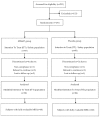Evaluation of a High Concentrate Omega-3 for Correcting the Omega-3 Fatty Acid Nutritional Deficiency in Non-Alcoholic Fatty Liver Disease (CONDIN)
- PMID: 30127297
- PMCID: PMC6115838
- DOI: 10.3390/nu10081126
Evaluation of a High Concentrate Omega-3 for Correcting the Omega-3 Fatty Acid Nutritional Deficiency in Non-Alcoholic Fatty Liver Disease (CONDIN)
Abstract
This randomized controlled trial investigated the safety and efficacy of MF4637, a high concentrate omega-3 fatty acid preparation, in correcting the omega-3 fatty acid nutritional deficiency in non-alcoholic fatty liver disease (NAFLD). The primary end point of the study was set as the change of red blood cell (RBC) eicosapentaenoic acid (EPA) and docosahexaenoic acid (DHA) by MF4637. Whether the omega-3 concentrate could lower liver fat was evaluated in a subset of patients. Furthermore, 176 subjects with NAFLD were randomized to receive the omega-3 concentrate (n = 87) or placebo (n = 89) for 24 weeks, in addition to following standard-of-care dietary guidelines. The omega-3 index, omega-6: omega-3 fatty acid ratio and quantitative measurements of RBC EPA and DHA were determined at baseline and study completion. Magnetic resonance imaging of liver fat was conducted in a subset of patients. Administration of high concentrate omega-3 for 24 weeks significantly increased the omega-3 index and absolute values of RBC EPA and DHA, and decreased the RBC omega-6: omega-3 fatty acid ratio (p < 0.0001). A significant reduction in liver fat content was reported in both groups.
Keywords: DHA; EPA; NAFLD; non-alcoholic fatty liver disease; omega-3 fatty acid; omega-3 index.
Conflict of interest statement
D.T. and Y.Q. are employees of BASF AS; M.B.A. is a former employee of BASF AS; P.C.C. is an advisor to BASF AS; J.K.I. has no conflicts to declare.
Figures
References
-
- Chalasani N., Younossi Z., Lavine J.E., Diehl A.M., Brunt E.M., Cusi K., Charlton M., Sanyal A.J. The diagnosis and management of non-alcoholic fatty liver disease: Practice Guideline by the American Association for the Study of Liver Diseases, American College of Gastroenterology, and the American Gastroenterological Association. Hepatology. 2012;55:2005–2023. doi: 10.1002/hep.25762. - DOI - PubMed
Publication types
MeSH terms
Substances
LinkOut - more resources
Full Text Sources
Other Literature Sources
Medical
Research Materials



